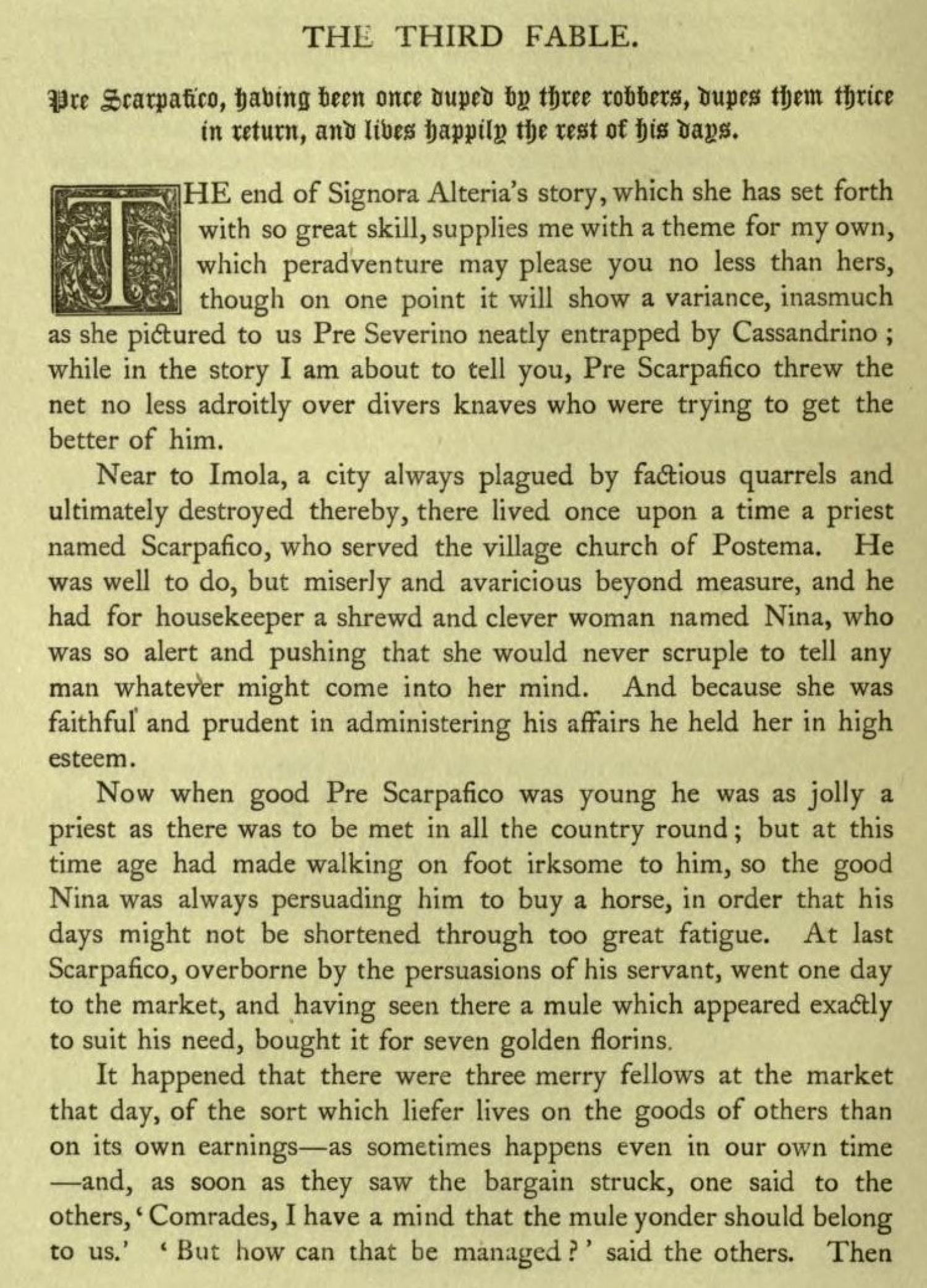“First Night, Third Fable.” The Nights of Straparola, Straparola, Giovanni Francesco, translated by Waters, W.G. (William George), London: Lawrence and Bullen, 1894, pp. 28-34.

Tale Summary
This tale is a twist on the one previously told, in which the character described is a victim caught between a city prætor and thief, and now focuses on his own fast-thinking. The village church of Postema is served by the avaricious priest Scarpafico, whose cunning housekeeper, named Nina, convinces him to buy a mule. 3 men at the market watch the transaction and plan to take the animal for themselves by waiting along his journey home, about a quarter-mile apart, and each separately insulting the mule as an ass. Their plan works and Scarpafico gives it to the last man he meets and walks home, where Nina reproaches him for falling for the trick. The priest requests Nina to prepare a lavish meal and makes use of two identical goats in his own trick, leaving one tied up at home and bringing the other to the market. Upon meeting the 3 thieves again, Scarpafico invites them to dinner, then packs food onto the animal’s back and commands it to bring the ingredients home. Although the goat wandered off to who-knows-where, the 3 men see the identical goat waiting at home, and the same ingredients cooked into a meal, and convince Scarpafico to sell them the animal for 50 gold florins. When they attempt what they thought the priest achieved, the goat wanders off, and their wives mock them. Scarpafico anticipates they will revisit him to take revenge, so he instructs Nina to hide a bladder full of blood under her clothes so that he can appear to stab and kill her. When the 3 men arrive and bear witness to this performance, the priest plays a bagpipe and acts as though it has raised her from the dead when she stands up. The 3 men eagerly buy the bagpipe, and soon one kills his wife in a rage. After the bagpipe does not revive her, another of the men proclaimed he was doing it wrong and killed his own wife to demonstrate. The third man killed his wife in an unrelated incident, and all 3 capture the priest and put him in a sack to be drowned. On the way to the river the men are spooked by something and leave the bag on the ground, where a shepherd lets out Scarpafico, who tells the man he is destined to marry a woman he does not want to; the shepherd is tricked into getting into the bag as the priest tricks him into thinking he will bring him to the woman to be wed in his place. He tosses the bag into the river and drowns the shepherd, and the 3 thieves are amazed to find Scarpafico among the flock of sheep and beg to be thrown into the water so that they may too emerge with flocks. Scarpafico agrees, and drowns them, returning to Nina to live in prosperity.
Fairy Tale Title
First Night, Third Fable
Fairy Tale Author(s)/Editor(s)
Giovanni Francesco Straparola
Fairy Tale Illustrator(s)
None listed
Common Tale Type
Tale Classification
Page Range of Tale
pp. 28-34
Full Citation of Tale
“First Night, Third Fable.” The Nights of Straparola, Straparola, Giovanni Francesco, translated by Waters, W.G. (William George), London: Lawrence and Bullen, 1894, pp. 28-34.
Original Source of the Tale
Giovanni Francesco Straparola
Tale Notes
Cateruzza tells this tale, and her enigma is:
“A sturdy blacksmith and his wife,
Who lived a simple honest life,
Sat down to dine; and for their fate
A loaf and a half of bread was there.
But ere they finished came the priest,
And with his sister joined the feast.
The loaf in twain the blacksmith cleft,
So three half loaves for the four were left.
Each ate a half, each was content.
Now say what paradox is meant.”
The solution is that the blacksmith’s wife is also the sister of the priest, making the division of food correct.
Research and Curation
Kaeli Waggener, 2022
Book Title
The Nights of Straparola
Book Author/Editor(s)
Giovanni Francesco Straparola
Illustrator(s)
Edward Robert Hughes
Publisher
Lawrence and Bullen
Date Published
1894
Decade Published
1890-1899
Publisher City
London
Publisher Country
United Kingdom
Language
English
Rights
Public Domain
Digital Copy
Available at the Internet Archive
Book Notes
This book is a collection of stories that are structured under a ‘frame tale,’ or overarching narrative. After the departure of Milan’s ruler amongst unrest, a party is held on the Island of Murano, with his daughter and her 10 court ladies taking turns to tell stories over the course of 13 nights. Each night 5 ladies will sing before narrating a tale on an agreed-upon theme, offering a pastime and a way to stimulate the wit.
Notes on narrators
Lodovica; admired for her beautiful eyes
Vicenza; possessing beauty and good manners
Lionora; kindly and courteous despite her haughty appearance
Alteria; devoted in service
Lauretta; disdainful and seductive
Eritrea; petite and beautiful
Cateruzza (surnamed Brunetta); graceful, loving, alluring
Arianna; young but grave, virtuous, and well-spoken
Isabella; highly gifted and witty
Fiordiana; Intelligent and willing

